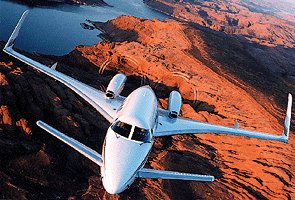
A tailplane, also known as a horizontal stabiliser, is a small lifting surface located on the tail (empennage) behind the main lifting surfaces of a fixed-wing aircraft as well as other non-fixed-wing aircraft such as helicopters and gyroplanes. Not all fixed-wing aircraft have tailplanes. Canards, tailless and flying wing aircraft have no separate tailplane, while in V-tail aircraft the vertical stabiliser, rudder, and the tail-plane and elevator are combined to form two diagonal surfaces in a V layout.

A delta wing is a wing shaped in the form of a triangle. It is named for its similarity in shape to the Greek uppercase letter delta (Δ).
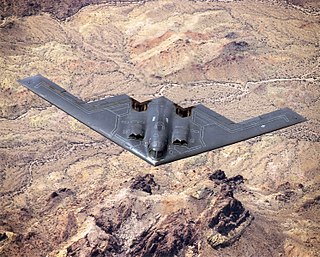
A flying wing is a tailless fixed-wing aircraft that has no definite fuselage, with its crew, payload, fuel, and equipment housed inside the main wing structure. A flying wing may have various small protuberances such as pods, nacelles, blisters, booms, or vertical stabilizers.

Aircraft flight control surfaces are aerodynamic devices allowing a pilot to adjust and control the aircraft's flight attitude.

The Northrop X-4 Bantam was a prototype small twinjet aircraft manufactured by Northrop Corporation in 1948. It had no horizontal tail surfaces, depending instead on combined elevator and aileron control surfaces for control in pitch and roll attitudes, almost exactly in the manner of the similar-format, rocket-powered Messerschmitt Me 163 of Nazi Germany's Luftwaffe. Some aerodynamicists had proposed that eliminating the horizontal tail would also do away with stability problems at fast speeds resulting from the interaction of supersonic shock waves from the wings and the horizontal stabilizers. The idea had merit, but the flight control systems of that time prevented the X-4 from achieving any success.

Elevators are flight control surfaces, usually at the rear of an aircraft, which control the aircraft's pitch, and therefore the angle of attack and the lift of the wing. The elevators are usually hinged to the tailplane or horizontal stabilizer. They may be the only pitch control surface present, and are sometimes located at the front of the aircraft or integrated into a rear "all-moving tailplane", also called a slab elevator or stabilator.

A stabilator, more frequently all-moving tail or all-flying tail, is a fully movable aircraft stabilizer. It serves the usual functions of longitudinal stability, control and stick force requirements otherwise performed by the separate parts of a conventional horizontal stabilizer and elevator. Apart from a higher efficiency at high Mach number, it is a useful device for changing the aircraft balance within wide limits, and for mastering the stick forces.

The empennage, also known as the tail or tail assembly, is a structure at the rear of an aircraft that provides stability during flight, in a way similar to the feathers on an arrow. The term derives from the French language verb empenner which means "to feather an arrow". Most aircraft feature an empennage incorporating vertical and horizontal stabilising surfaces which stabilise the flight dynamics of yaw and pitch, as well as housing control surfaces.
Flight mechanics are relevant to fixed wing and rotary wing (helicopters) aircraft. An aeroplane, is defined in ICAO Document 9110 as, "a power-driven heavier than air aircraft, deriving its lift chiefly from aerodynamic reactions on surface which remain fixed under given conditions of flight".
The United States Air Force Stability and Control Digital DATCOM is a computer program that implements the methods contained in the USAF Stability and Control DATCOM to calculate the static stability, control and dynamic derivative characteristics of fixed-wing aircraft. Digital DATCOM requires an input file containing a geometric description of an aircraft, and outputs its corresponding dimensionless stability derivatives according to the specified flight conditions. The values obtained can be used to calculate meaningful aspects of flight dynamics.

A vertical stabilizer, vertical stabiliser, or fin, is a structure designed to reduce aerodynamic side slip and provide directional stability. They are most commonly found on vehicles such as aircraft or cars. It is analogous to a skeg on boats and ships. Other objects such as missiles or bombs utilize them too. They are typically found on the aft end of the fuselage or body.

Mach tuck is an aerodynamic effect whereby the nose of an aircraft tends to pitch downward as the airflow around the wing reaches supersonic speeds. This diving tendency is also known as tuck under. The aircraft will first experience this effect at significantly below Mach 1.
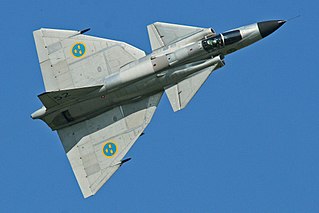
A canard is an aeronautical arrangement wherein a small forewing or foreplane is placed forward of the main wing of a fixed-wing aircraft. The term "canard" may be used to describe the aircraft itself, the wing configuration, or the foreplane.
If an aircraft in flight suffers a disturbance in pitch that causes an increase in angle of attack, it is desirable that the aerodynamic forces on the aircraft cause a decrease in angle of attack so that the disturbance does not cause a continuous increase in angle of attack. This is longitudinal static stability.

A tailless aircraft has no tail assembly and no other horizontal surface besides its main wing. The aerodynamic control and stabilisation functions in both pitch and roll are incorporated into the main wing. A tailless type may still have a conventional vertical fin and rudder.
In flight dynamics, longitudinal static stability is the stability of an aircraft in the longitudinal, or pitching, plane under steady flight conditions. This characteristic is important in determining whether a human pilot will be able to control the aircraft in the pitching plane without requiring excessive attention or excessive strength.
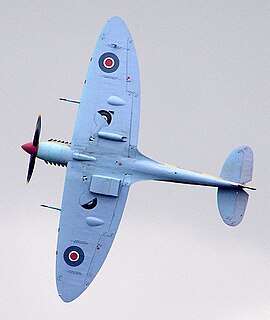
The wing configuration of a fixed-wing aircraft is its arrangement of lifting and related surfaces.

A three-surface aircraft or sometimes three-lifting-surface aircraft has a foreplane, a central wing and a tailplane. The central wing surface always provides lift and is usually the largest, while the functions of the fore and aft planes may vary between types and may include lift, control and/or stability.

In aircraft design, a chine is a longitudinal line of sharp change in the cross-section profile of the fuselage or similar body. The term chine originates in boatbuilding, where it applies to a sharp profile change in the hull of a boat. In a flying boat hull or floatplane float, the longitudinal line of sharp change in cross-section where the bottom plane meets the sidewall, is an example of a chine.
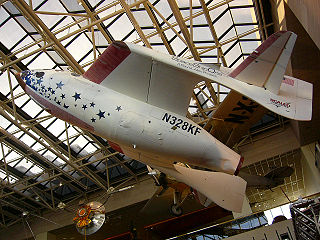
An outboard tail is a type of aircraft tail or empennage which is split in two, with each half mounted on a short boom just behind and outboard of each wing tip. It comprises outboard horizontal stabilizers (OHS) and may or may not include additional boom-mounted vertical stabilizers (fins). OHS designs are sometimes described as a form of tailless aircraft.




